Transform your dinner table with a side dish that’s not just effortlessly simple but bursting with incredible flavor and vibrant nutrients. This Sautéed Broccolini and Garlic recipe proves that healthy eating can be truly delicious and craveable. Imagine tender-crisp broccolini, infused with aromatic garlic and a subtle kick of red pepper flakes, ready to enjoy in less than 10 minutes. It’s a quick, easy, and incredibly versatile vegetable side that will become a new favorite in your culinary repertoire.
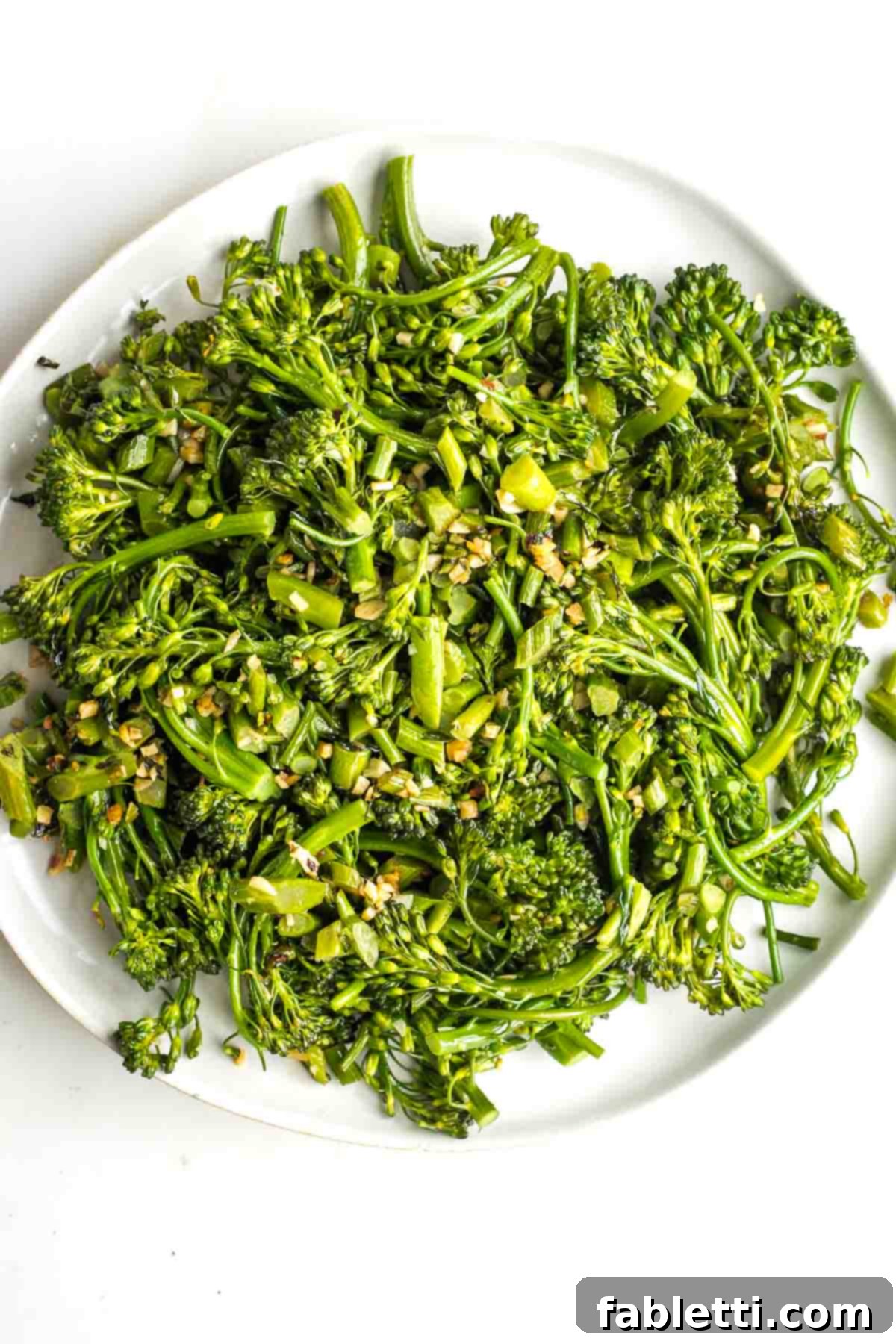
Why You’ll Love This Easy Sautéed Broccolini and Garlic Recipe
This simple broccolini recipe is more than just a side; it’s a game-changer for anyone looking to incorporate more wholesome vegetables into their diet without sacrificing taste or time. Here’s why this dish will quickly earn a permanent spot on your weekly menu:
- Unbelievably Quick & Easy: From the moment you start prepping to the first delicious bite, this dish is on your table in under 10 minutes. It’s the ultimate solution for busy weeknights or when you need a last-minute addition to your meal.
- Effortless Stovetop Cooking: Forget about preheating the oven! This recipe cooks entirely on your stovetop, making it super convenient and perfect for when you want to minimize kitchen cleanup and complexity.
- Packed with Flavor: Despite its simplicity, this sautéed broccolini is incredibly tasty. The combination of fresh garlic and a hint of red chili flakes elevates the natural sweetness of the broccolini, creating a flavor profile that’s both comforting and exciting. It’s proof that vegetables can be fun, delicious, and anything but bland!
- Simple, Wholesome Ingredients: The beauty of this dish lies in its minimal ingredient list. Fresh broccolini, quality olive oil, garlic, and a few seasonings are all you need. These simple components allow the delicate, slightly sweet flavor of the baby broccoli to truly shine.
- Dietary Friendly Side Dish: Naturally vegan and gluten-free, this sautéed broccolini is a fantastic option for virtually any dietary preference. It’s a healthy, inclusive side that everyone at your table can enjoy, making it ideal for family dinners or entertaining guests with diverse needs.
- Nutrient Powerhouse: Broccolini is rich in vitamins (C, K, A), folate, and fiber, while garlic offers immune-boosting properties. This dish doesn’t just taste good; it nourishes your body from the inside out.
Essential Ingredients and Smart Substitutions
Creating this delicious sautéed broccolini relies on a few core ingredients that come together harmoniously. Here’s what you’ll need and how you can adapt the recipe to your pantry or preferences:

- Broccolini: For this recipe, you’ll want about a pound, which usually translates to a couple of bunches of broccolini, also affectionately known as baby broccoli. Its slender stalks and small florets cook quickly and offer a milder, sweeter taste than its larger cousin.
- Substitution: If broccolini isn’t available, regular broccoli can certainly be used. Just be aware that its thicker stalks will require a slightly longer cooking time. You can also use broccoli rabe (rapini), but note that it has a distinctly more bitter flavor profile compared to broccolini’s natural sweetness. For regular broccoli, consider cutting the florets into smaller, bite-sized pieces and the stems into thin discs to ensure even cooking.
- Olive Oil: Extra virgin olive oil is crucial here, not just for its rich flavor but also for its health benefits. It aids in the absorption of the fat-soluble vitamins present in broccolini, making the dish even more nutritious.
- Substitution: If you’re looking to minimize oil, you can sauté the broccolini in a splash of water or vegetable broth. However, for optimal nutrient absorption and flavor, I recommend including healthy fats. If omitting oil during cooking, drizzle with tahini, a nut butter sauce, or sprinkle with nuts and seeds after cooking.
- Garlic: Fresh garlic cloves are non-negotiable for the best flavor in this dish. Their pungent aroma and savory notes are what make this broccolini truly shine.
- Substitution: In a pinch, garlic powder can be used (about ½ teaspoon per clove), but avoid garlic salt, which can make the dish too salty and lacks the fresh punch. For maximum health benefits and flavor, mince your fresh garlic cloves and let them sit for 5-10 minutes before cooking. This allows the allicin, a powerful antimicrobial compound, to fully develop. A microplane grater is excellent for achieving a fine mince.
- Salt and Pepper: I prefer coarse-grain sea salt for its texture and mineral content, along with a healthy pinch of red pepper flakes to add a delightful warmth and subtle heat.
- Substitution: For a milder flavor profile, simply use freshly ground black pepper instead of red pepper flakes. Adjust the amount of salt to your personal taste – a little goes a long way in enhancing the natural flavors.
A Guide to Choosing the Right Broccoli
Understanding the different types of broccoli and how to select the freshest produce will elevate your cooking. Remember, no matter the type, the entire vegetable is edible! The florets are generally sweeter, the leaves are packed with antioxidants, and the stems are loaded with beneficial fiber. When choosing, look for deep green or even purplish florets. Yellow flowers, while edible, indicate the plant was left in the field longer and might have a more bitter taste.
- Regular Broccoli (Calabrese): This is the most common variety found in grocery stores across the US, named after Calabria, Italy. It features thick, lighter green stalks and dense, dark green, compact florets. It’s versatile and robust, suitable for roasting, steaming, and sautéing, though its stems require longer cooking or thinner slicing.
- Chinese Broccoli (Gai Lan / Chinese Kale): Distinctive for its long, thick stems and large, dark green, cabbage-like leaves. Gai lan has a slightly bitter, peppery flavor and a crisp texture. It’s exceptionally rich in beta-carotene and a good source of Vitamin E, often used in stir-fries and blanched as a side.
- Baby Broccoli (Broccolini): A delightful hybrid of regular broccoli and Chinese broccoli. Broccolini boasts longer, thinner stalks and smaller, more delicate florets compared to traditional broccoli. Its flavor is generally milder, sweeter, and softer, and it cooks much more quickly, making it ideal for quick sautéing. This is the star of our recipe!
- Broccoli Rabe (Rapini): Not a true broccoli but closely related to turnips, broccoli rabe is known for its slender stems, small, leafy florets, and a pronounced bitter taste. It’s often embraced in Italian cuisine for its unique pungency. Blanching it briefly before sautéing can help reduce some of its bitterness.
- Romanesco Broccoli: A visually stunning vegetable that looks like an intricate, spiraled cauliflower with a chartreuse color. Romanesco offers a delicate, nutty flavor that’s milder than regular broccoli and less bitter than cauliflower, with a firm, slightly crunchy texture. Its nutritional profile is similar to broccoli, and it’s fantastic roasted or steamed.
How to Expertly Trim Broccolini for Even Cooking
Properly trimming your broccolini is a simple step that makes a huge difference in achieving evenly cooked, tender-crisp results. Since the slender stems are heartier than the delicate florets, we’ll cook them in stages. Grab two separate bowls to keep the trimmed parts organized.
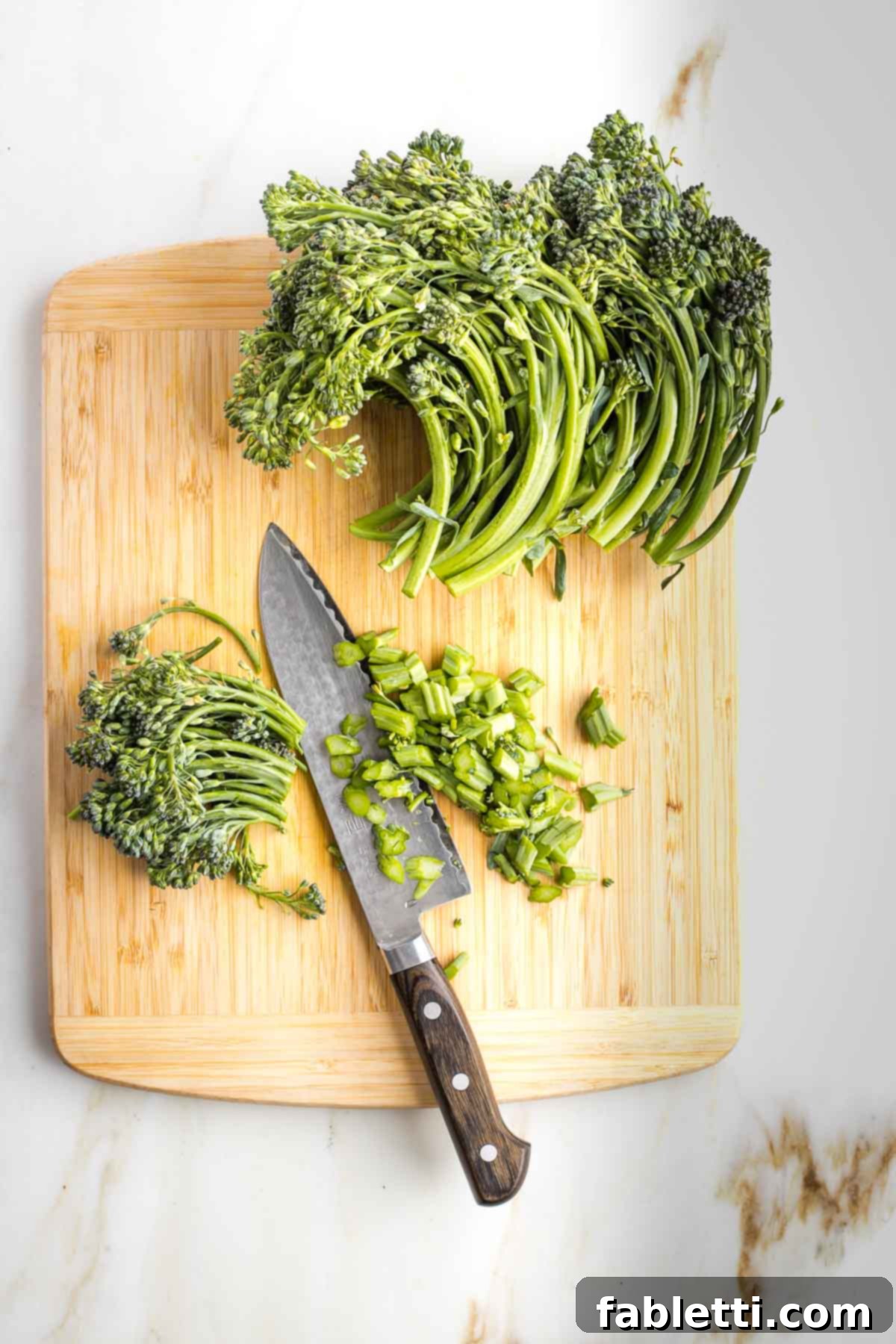
Begin by cutting off the very bottom, woody ends of the broccolini stems – usually about the bottom third. Slice these thicker stem pieces into ½-inch discs. These pieces are tougher and will benefit from a head start in the pan.

Place these thicker, sliced stem pieces into one small bowl. The remaining thinner stems and the florets go into another separate bowl. If your broccolini has leaves, don’t discard them! They are packed with flavor and nutrients; simply add them to the bowl with the florets.
Continuing Your Ingredient Preparation for Seamless Cooking
Once your broccolini is trimmed, it’s time to get the rest of your ingredients ready. This practice, known as “mise en place,” ensures a smooth and stress-free cooking experience, especially for a quick stovetop dish like this.
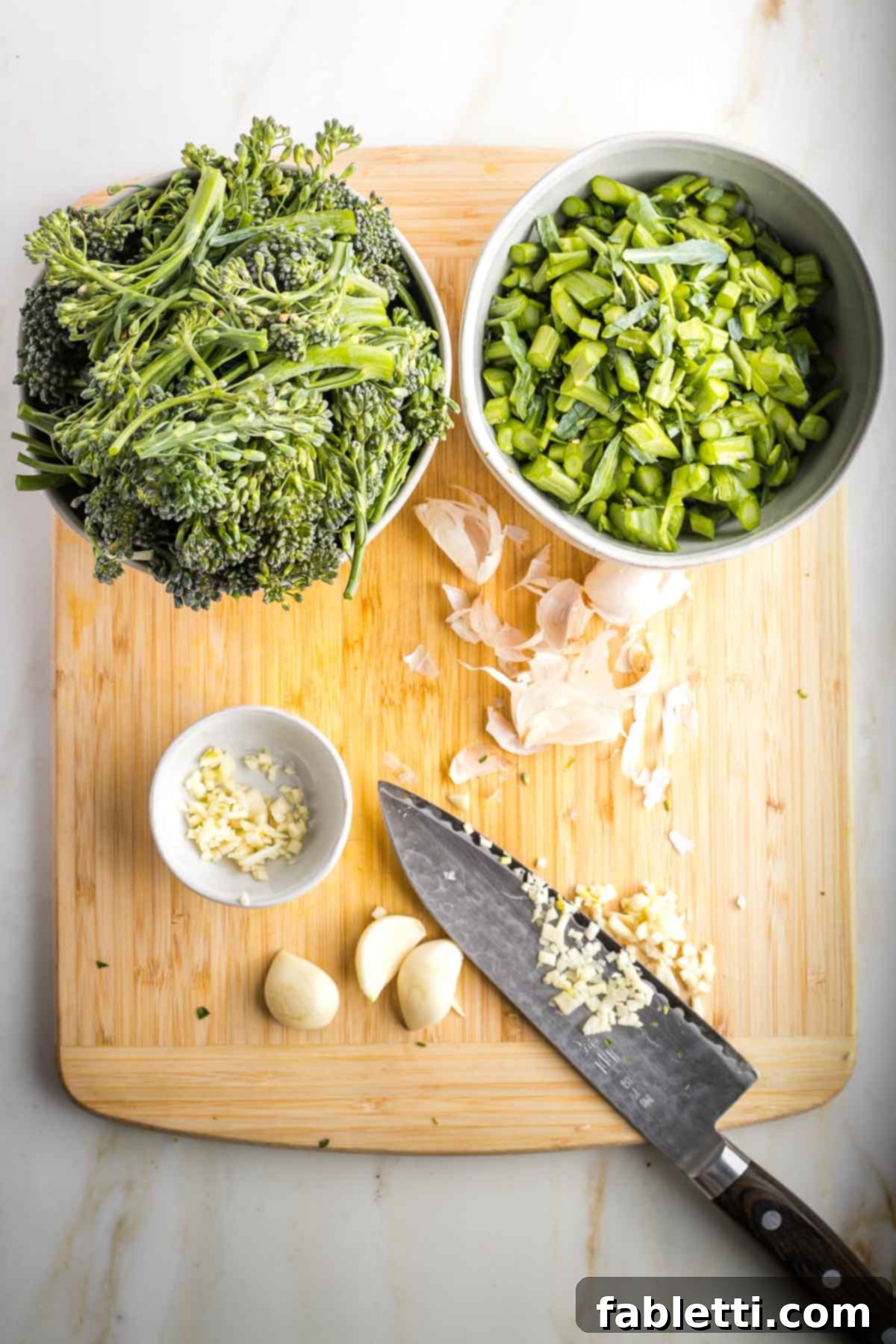
Peel and mince your fresh garlic cloves. For the finest mince, you can also use a microplane grater. Remember to let the minced garlic sit for a few minutes before adding it to the hot pan to maximize its beneficial compounds. This small step enhances both flavor and nutrition.
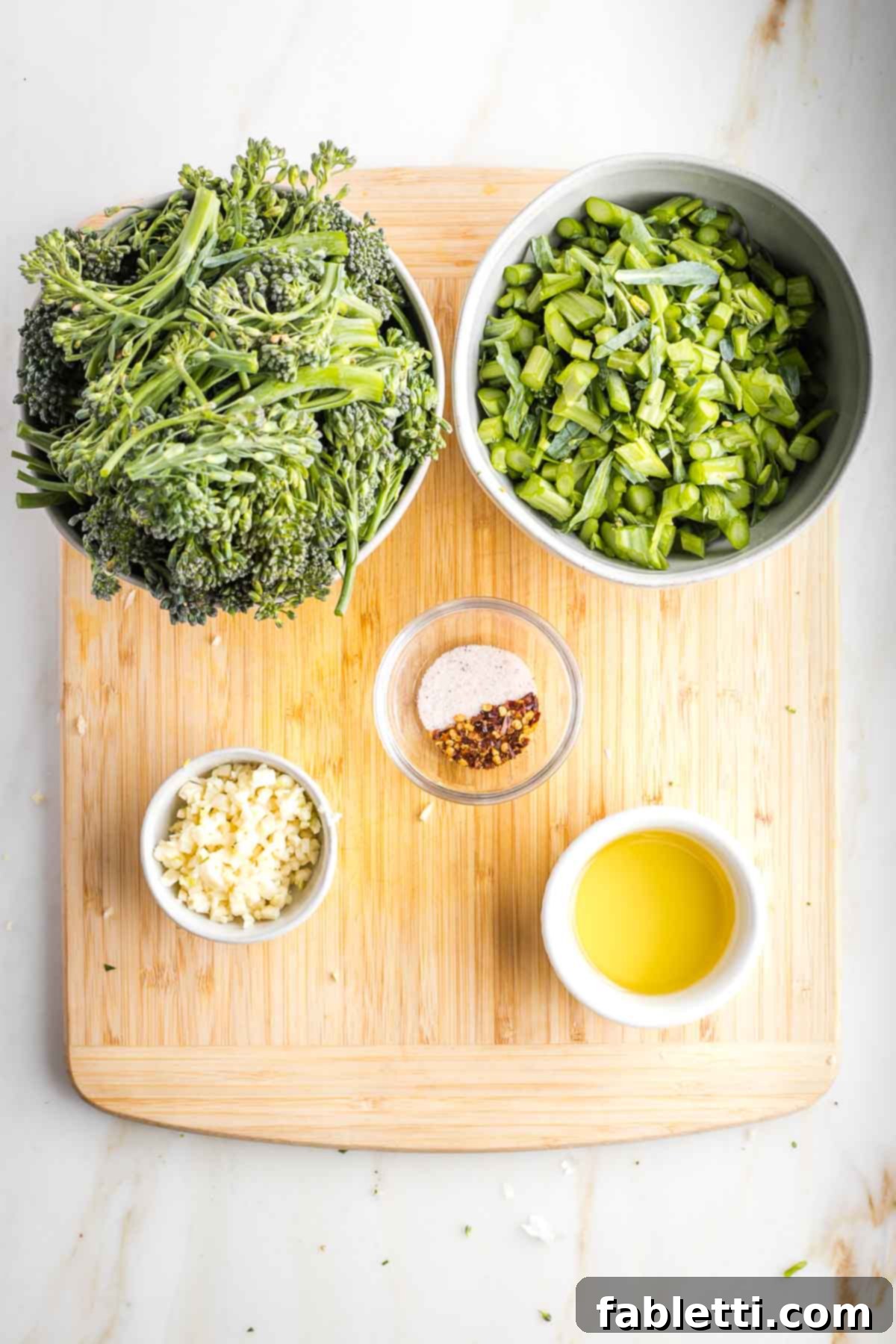
Measure out your olive oil, sea salt, and crushed red pepper. Having everything pre-measured and within arm’s reach before you heat the skillet will allow you to move quickly and confidently through the cooking steps, preventing any frantic searching or potential burning.
Mastering the Sauté: A Step-by-Step Guide to Perfect Broccolini
Sautéing broccolini is a quick and effective way to bring out its natural sweetness and achieve that desired tender-crisp texture. The key is proper heat management and adding ingredients at the right time. Here’s how to do it perfectly:
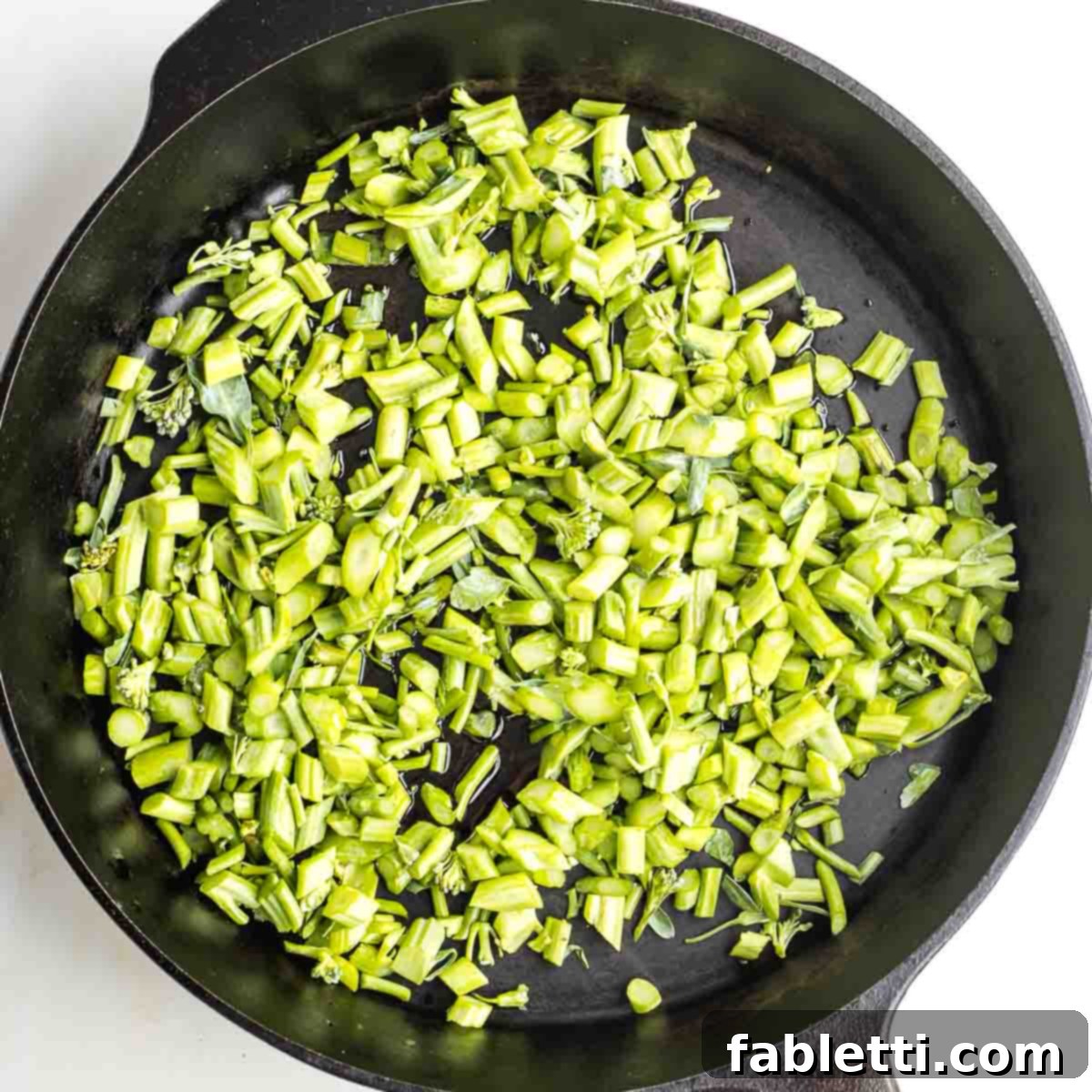
Step 1: Heat the Skillet and Sauté Stems. Place a large skillet over medium-high heat. You want the pan hot before adding anything. A cast iron skillet is excellent for this as it retains heat beautifully, but any large, heavy-bottomed skillet will work. Once hot, add 1 tablespoon of olive oil and the chopped, thicker broccolini stems. If you prefer not to use oil, you can use a little water or veggie broth, but a non-stick skillet might not give you the same browning results.

Step 2: Season and Cook. Sprinkle the broccolini stems with sea salt and red pepper flakes. Sauté for 2-3 minutes, stirring frequently. You’re looking for the stems to begin to soften and develop a slight char, indicating they’re starting to cook through.

Step 3: Add Garlic. Create a small space in the center of the pan and add the minced garlic. Immediately reduce the heat to medium. Garlic cooks very quickly and can burn easily, so managing the heat is essential at this stage.
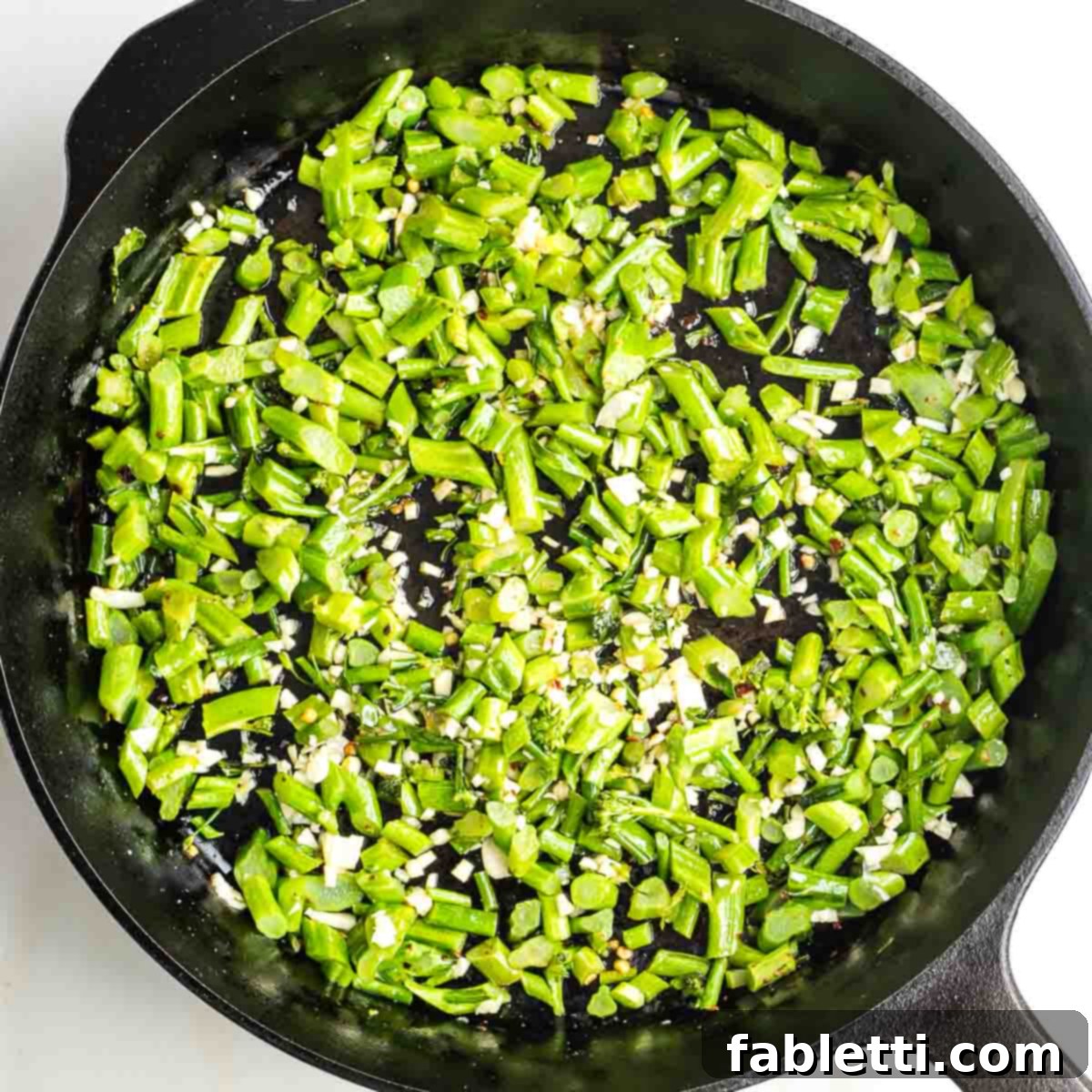
Step 4: Cook Garlic (Briefly!). Cook the garlic, stirring constantly, for about 30 seconds. It should become fragrant but not browned or burnt. The goal is to infuse its aroma into the oil and broccolini, not to caramelize it heavily at this stage.

Step 5: Introduce Florets and Finish. Add the broccolini florets and thinner stems (along with any leaves) to the pan. Drizzle with the remaining tablespoon of olive oil. Stir everything together, ensuring the garlic and oil are evenly distributed.
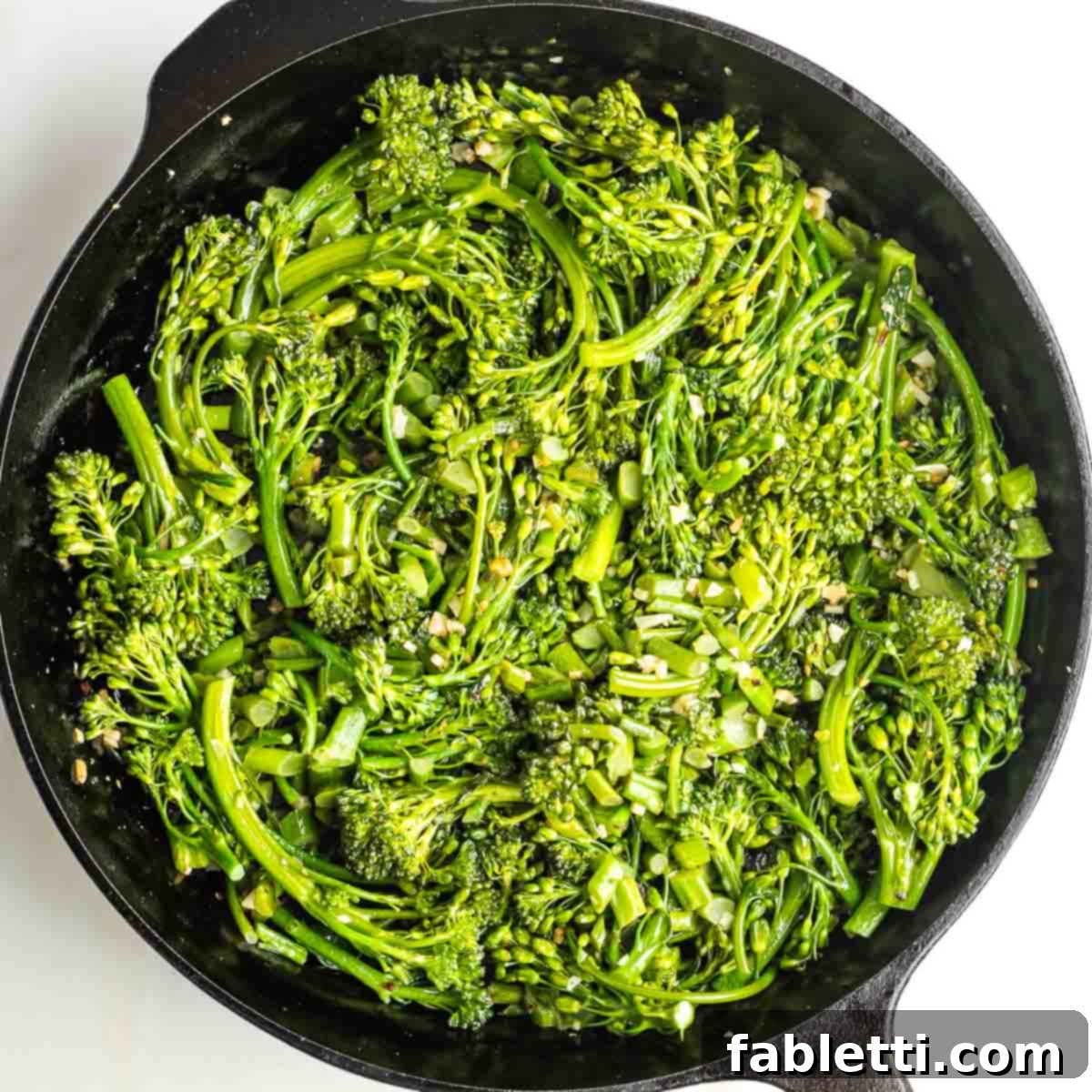
Step 6: Sauté to Perfection. Continue to stir and cook for another 2 minutes. The entire dish will transform, with the broccolini turning a vibrant, bright green when it’s perfectly al dente – tender with a slight crispness. Be careful not to overcook, as it can become mushy and lose its appealing color.
Once cooked, immediately transfer the sautéed broccolini and garlic to a serving dish. This prevents it from continuing to cook in the hot skillet, which can lead to overcooked, less appealing vegetables. Serve warm, or it’s equally delicious at room temperature.
Beyond Broccolini: Applying This Sauté Method to Other Vegetables
The cooking technique used for this broccolini, starting with the heartier parts first, is incredibly versatile and can be applied to many other vegetables to ensure even cooking and optimal texture. This method guarantees that no part of your vegetable is left undercooked or overcooked.
- The core principle is simple: cook the denser, tougher parts of the vegetable first, allowing them to soften slightly before adding the more tender leaves or florets. This staggered approach ensures everything reaches perfect doneness simultaneously.
- A fantastic visual cue for many green vegetables is their color. When they turn a vibrant, bright green, they’re typically done al dente – tender-crisp and full of life. If they start to turn a darker, dull green or become olive-colored, they’re likely overdone and may lose their appealing texture.
- Consider leafy greens with substantial stems:
- Radish Tops, Turnip Greens, and Beet Greens: These often come attached to their root vegetables and are delicious when cooked. Separate the leaves from their stems. Thinly chop the stems and sauté them for a few minutes until tender, then add the chopped leaves to the pan and cook until just wilted and bright green.
- Kale (Lacinato/Dinosaur Kale, Curly Kale), Swiss Chard, Collard Greens: These hearty greens all benefit from this approach. Remove the tough central rib (stem) from the leaves. Thinly slice the ribs and sauté them first until they start to soften. Then, add the chopped leafy portions and cook until tender-crisp.
- Asparagus: While not a leafy green, asparagus stalks vary in thickness. Snap off the woody ends. For thicker spears, you can slice the bottom halves into rounds and sauté them briefly before adding the tips.
- Green Beans: Trim the ends. For very thick green beans, a similar approach can be used, giving the thicker beans a minute or two head start before adding thinner ones, or slicing them diagonally.
- A note on garlic: Regardless of the vegetable, remember that garlic can burn very easily. Always add it towards the end of the cooking process, usually just 30 seconds to a minute before the vegetables are fully cooked. Stir constantly to prevent it from scorching, which can impart a bitter taste to your dish.
- Flavor Variations: Experiment with this method by adding a squeeze of fresh lemon juice at the end for brightness, a dash of sesame oil and sesame seeds for an Asian twist, or a sprinkle of fresh herbs like parsley or chives for added freshness.
Debra’s Pro Tips for the Best Sautéed Broccolini

- No Need to Boil: Broccolini, with its slender stems, cooks incredibly quickly on the stovetop. There’s no need to boil or blanch it beforehand. A direct sauté preserves more nutrients and ensures a better texture. If your pan seems too dry during cooking, a small splash of water (a tablespoon or two) can help create steam and prevent burning without making the vegetables soggy.
- Brighten with Lemon: For those who love a citrusy kick, serve your sautéed broccolini with fresh lemon wedges. A squeeze of fresh lemon juice just before eating adds a bright, zesty contrast that perfectly complements the garlic and subtle heat. I recommend adding it individually rather than to the entire dish, allowing everyone to customize their plate.
- Perfect Family Dinner Side: This easy sautéed broccolini recipe is ideal for family dinners. For a rustic and charming presentation, simply place your hot cast iron skillet directly onto a trivet on the table and serve straight from the pan. It keeps the broccolini warm and adds a homey touch to your meal.
- Storage and Reheating: Have leftovers? Store them in an airtight container in the fridge for up to 5 days. This dish is versatile and can be enjoyed cold, at room temperature, or gently reheated. To reheat, simply toss it in a hot skillet for 1-2 minutes until warmed through, being careful not to overcook it.
- Pairing Suggestions: Sautéed broccolini is a fantastic companion to a wide array of main courses. It pairs wonderfully with grilled chicken or fish, roasted tofu, pasta dishes, or even as a vibrant addition to grain bowls.
Explore More Healthy Side Dish Recipes
Looking for more delicious and nutritious ways to complete your meals? Here are some other healthy side dish recipes that are just as easy and flavorful:
- Mediterranean Cauliflower Rice
- Easy Recipe for Green Beans with Almonds
- Crispy Oven Roasted Brussels Sprouts (Honey Sriracha Sauce)
- Oven Roasted Crispy Broccoli
We love hearing from you! If you made this delicious Sautéed Broccolini and Garlic recipe, please consider leaving a five-star rating and a comment below to share your experience. Your feedback is invaluable and helps other home cooks discover wonderful recipes. Don’t forget to share your culinary creations on Instagram by tagging me @dkhealthcoach and using the hashtag #debraklein – I can’t wait to see your vibrant dishes!
Sautéed Broccolini and Garlic Recipe

Sauteed Broccolini and Garlic
Author: Debra Klein
Veggies that are irresistible? You bet…with this sautéed broccolini that’s cooked with a fragrant blend of garlic and crushed red pepper. Each tender bite reveals a perfect balance of vibrant flavor, with a hint of heat from the pepper and just a touch of natural sweetness from the greens.
5 out of 5 stars (22 votes)
Pin Recipe
- Prep Time
- 3 mins
- Cook Time
- 5 mins
- Total Time
- 8 mins
- Course
- Side Dish
- Cuisine
- American
- Servings
- 4
- Calories
- 120 kcal
Equipment
- Cast iron skillet
- Cutting Board
- Chef’s knife
Ingredients
- 1 lb broccolini
- 2 tablespoon olive oil, divided
- ½ teaspoon sea salt
- ½ teaspoon crushed red pepper
- 5 cloves garlic, minced
Instructions
- Wash broccolini and pat dry. Chop the bottom third of the broccolini stems into ½-inch discs and set aside in one bowl. Leave the tops (florets and thinner stems) intact, separating any very large clusters, and set aside in a separate bowl. Mince the garlic cloves.
- Heat a large skillet over medium-high heat. Swirl in 1 tablespoon of the olive oil, then add the chopped broccolini stems. Reduce the heat to medium. Sprinkle with salt and crushed red pepper and cook, stirring for about 3 minutes, until they begin to soften.
- Stir in the minced garlic cloves and cook for 30 seconds, stirring constantly, until fragrant. Be careful not to let the garlic burn. Add the remaining tablespoon of olive oil and the broccolini tops (florets and thinner stems).
- Stir and cook for another 2 minutes, or until the broccolini turns a vibrant bright green and the stems are tender-crisp but not mushy.
- Serve immediately, or transfer to a plate and serve at room temperature.
Notes
Storage: Store any leftover sautéed broccolini in an airtight container in the refrigerator for up to 5 days. It can be enjoyed cold, at room temperature, or reheated gently in a skillet for 1-2 minutes until warm.
Nutrition
Carbohydrates: 8 g
Protein: 4 g
Fat: 8 g
Saturated Fat: 1 g
Polyunsaturated Fat: 1 g
Monounsaturated Fat: 6 g
Sodium: 328 mg
Potassium: 5 mg
Fiber: 1 g
Sugar: 3 g
Vitamin A: 2075 IU
Vitamin C: 104 mg
Calcium: 81 mg
Iron: 1 mg
Note
The nutrition calculations were done using online tools. To obtain the most accurate representation of the nutritional information in any given recipe, you should calculate the nutritional information with the actual ingredients you used. You are ultimately responsible for ensuring that any nutritional information is accurate, complete, and useful.
